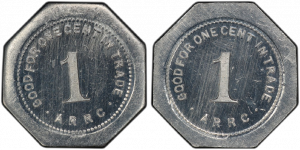The Alaska RRC Bingle: A New Deal Era Coin Used by Farmers
Posted onImagine you were struggling financially during the Great Depression. In that scenario, a government offer to move you to Alaska to farm a 40-acre plot of land could have sounded like a good deal.

Indeed, 203 pioneer families did just that in May 1935 as part of President Franklin D. Roosevelt’s New Deal plan to help move the country out of the Great Depression through massive public works projects.
The adventuresome pioneers moved to Matanuska Valley, about 45 miles northeast of Anchorage, Alaska, hoping to start a new and more fruitful life. The farmers were chosen from Minnesota, Wisconsin, and Michigan as the government theorized that those folks would be well suited to Alaska’s harsh climate, given the cold winters they were already used to.
The Alaska Rural Rehabilitation Corporation (ARRC) governed the new farming colony and the U.S. government issued coins that were legal tender and could be used in the ARRC stores. This included the one–cent Alaska RRC Bingle minted in 1935 and 1936.
The one-cent Alaska Bingle is not only one of the shortest-lived coins in U.S. history, it is also one of the most unusual.
Three factors help make this one of the most unusual coins ever minted by the U.S. government.
The first is its shape. The one-cent Bingle is an octagon, meaning it is an eight-sided coin. The second unusual factor is that it is made of aluminum. Until the government struck the one-cent Bingle, only pattern coins had been produced in aluminum. Finally, the same design is evident on both the front and the back of the coin!
This historic coin with eight sides features a large number “1” with the words: “Good for one cent in trade ARCC” encircling the coin.
The one-cent Alaska Bingle was struck along with a series of other RRC coins including the five-cent, 10–cent, 25–cent, 50–cent, one-dollar, five dollar, and 10 dollar denominations. Only the one–cent Bingle was not round. Because legal tender currency was so scarce in rural Alaska during the Great Depression, it is believed that these coins were also used as currency outside the ARCC stores.
However, after minting these coins for only two years, the government removed their legal tender status and they were recalled. Only several hundred coins were saved from the recall, which means survivors today are incredibly scarce although the few known survivors are almost all in mint condition, or close to it. Imagine the stories that these coins could tell if they could talk: settlers in faraway Alaska, who dreamed of a better life and took the opportunity to try to build that when it was offered.
Want to read more? Subscribe to the Blanchard Newsletter and get our tales from the vault, our favorite stories from around the world, and the latest tangible assets news delivered to your inbox weekly.







